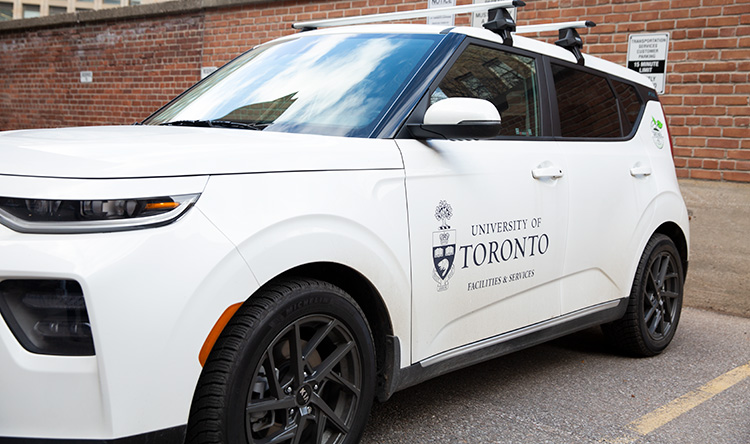Driving into a low-carbon future with a green fleet
F&S is planning to eliminate 169 tonnes of greenhouse gases each year by replacing our entire fleet with electric vehicles. Read more about how we’ll do it.
Facilities & Services has approximately 50 gasoline- or diesel-powered vehicles covering campus safety, recycling, caretaking, grounds, moving, mail, and trades—making it one of the largest university vehicle fleets in Canada. Pickup trucks, vans, SUVs, and compacts are used to move staff, equipment, parts, and waste around campus.


Chelsea Dalton, project manager at the Sustainability Office, is eager to contribute to the Climate Positive Campus Plan—which has the goal of reducing 80% of emissions on campus—by replacing today’s fleet with electric vehicles.
F&S has done its homework to plan the replacement process. Dalton assigned each vehicle a priority for replacement based on emissions, age, and the availability of a suitable electric alternative. Ron Saporta, chief operating officer, property services & sustainability, wanted to immediately start by replacing high-priority vehicles with electric ones.
F&S’s long-term goal is to become a zero-emissions fleet. To get there, we are converting from gasoline or diesel-powered vehicles to electric vehicles. Currently, F&S has four electric vehicles and is replacing three gas-powered vehicles with electric ones in early 2022.
Due to supply chain issues and vehicle availability, replacing the fleet’s pickup trucks and cargo vans with electric options is a lengthy process. In the meantime, the electric Kia Soul EV is a popular pick for F&S until electric pickup trucks and cargo vans become available in Canada.
Replacing the entire vehicle fleet will eliminate 169 tonnes of greenhouse gases annually. This is equivalent to the greenhouse gas emissions produced by an average passenger vehicle driving over 680,000 kilometres.
F&S will use electric vehicle charging stations already available on the St. George campus and new stations as needed to charge the vehicles’ batteries. The electricity for the vehicle charging stations comes from the Ontario electricity grid and creates some greenhouse gases—but much less than using gasoline or diesel as fuel in an internal combustion engine.
Eventually, as part of the climate positive plan, F&S will generate enough renewable energy to offset any remaining emissions from the electricity grid—including those used to charge F&S vehicles. F&S will also be keeping an eye out for emerging technologies that may bring them closer to a zero-emissions fleet sooner.
Other Canadian universities such as McMaster and McGill have similar plans to reduce vehicle fleet emissions, and the TTC is planning to have an emissions-free fleet by 2040. The City of Toronto also has a plan to transition 45% of its fleet to low-carbon vehicles by 2030.
Before replacing any vehicles, F&S consulted with the managers of each division. The managers then talked to their staff to ensure that F&S was providing a replacement that meets their needs. Staff test-drove the Kia Soul EV prior to beginning the procurement process for these vehicles and they were highly satisfied with it.
“Our staff love the Kia Soul EV,” said Michelt Carvalho, manager of building automation and operations at F&S. “With the Kia Soul, the staff are more mobile and efficient in their work and don’t have to deal with the maintenance breakdowns that come with older gasoline cars.”
